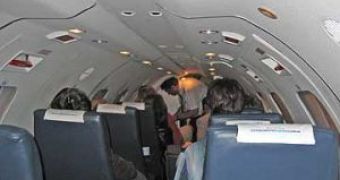The profound venous thrombosis, tourist class thrombosis or traveler's syndrome occurs after staying several hours in the same posture, not necessary on a plane and not necessary on seats of the tight tourist class.
At least five airlines which make long distance flights around the world are faced with the huge demands of Australian tourists that suffered by this syndrome.
The clots formed inside the inferior veins pass in the blood stream to the lungs, where they can trigger a pulmonary embolism and death by asphyxia.
The persons suffering by obesity, varicose veins, heart disease, older than 50 or smokers are the most exposed to thrombosis.
But there are also other risk factors, like habits, genes, low pressure on the plane's cabin (which reduces the lungs' capacity and the oxygen level in the blood), alcohol intake (which dehydrates the body) and the air too dry inside the plane's cabin (which increases dehydration and thrombosis risk).
If clots form in the ankle, they are less dangerous, only provoke a slight pain and a small swelling.
When they form on the femoral area, they provoke pain and swelling above the knees.
If the clots appear in the iliac area, they provoke great pain in all the leg and a generalized inflammation.
In Heathrow Airport (London), 10 persons die annually by this condition and the situation is similar in other big airports in UE or Japan.
If you have to take a flight longer than five hours, here are some advices:
- Make a short walk for every hour of flight.
-If you cannot walk, move your toes, ankle and knee or the legs on the seat.
- Do not cross the legs.
- Drink a lot of liquids, but avoid alcohol.
- Do not put baggage under the front seat, reducing this way the available space.
-Do not sleep cowered.
-Do not take sleeping pills.
_ If you are not allergic and do not suffer by stomach, take aspirin in small doses, it avoids clots' formation.

 14 DAY TRIAL //
14 DAY TRIAL //